Naturally Better, One Step At a Time
Here are the stories of how seven regenerative farmers and ranchers found their success and lessons that Noble has learned after one year of regenerative ranching.
Jump to section:
Naturally Better
Regeneratively-managed land is characterized by a practical sort of beauty. Instead of conventional pastures of a single, uniform grass, these farms and ranches are alive with nature’s diversity. Their mixture of plant species attracts beneficial insects and wildlife, nourishes grazing animals, and provides for the humans caring for them.
The foundation for this naturally complementary system all starts with building more life into the soil. And more soil life starts with partnering with nature.
Regeneratively-managed land teems with more biodiversity from the plant life to the animal life. Both returning naturally. Both attracted to the drought- and flood-resilient land that now holds more water. Both benefiting from cleaner, healthier watersheds from any runoff. Both realized because the soil below is filled with trillions of microorganisms — the foundational life of society.
From the rancher and farmer point of view, working with nature also strengthens their bottom line. As chemical inputs decrease, so do expenses. It’s a mutually beneficial partnership with nature that grows benefit upon benefit. Here are the stories of how seven regenerative farmers and ranchers found that partnership, found that balance, and found their success.

Regenerative agriculture practices help native plants and beneficial insects flourish in a diverse ecosystem.
Creating a Welcoming Environment For Wildlife
In Wild Company
The only wildlife Steve Tucker saw on his farm in western Nebraska was an occasional rabbit and plenty of crop-damaging insects. He needed to attract better company.
A rainfall simulator presented by a local Natural Resources Conservation Service event opened Steve’s eyes to the possibilities. Different management practices had the ability to influence soil health, so he switched to no-till in the late ’90s.
Through time, Steve added cover crops to his mostly wheat farm and integrated livestock. Today, he grows about 15 different crops, such as small grains, pulses and grasses, and a diverse cover crop mix for grazing.
The wildlife noticed.
If I just do things in accordance with nature, the wildlife will promote itself. The land will flourish.
Steve Tucker, Venango, Nebraska
As Steve added diversity to his farm, more wildlife appeared. His farm attracted more birds, deer, badgers, foxes and coyotes. Although some may view his new friends with trepidation, Steve says predators have an important place in the ecosystem. They tell him his farming is in sync with nature.
In addition to providing wildlife habitat, Steve’s diverse crop rotations also nourish the soil. Healthier soil grows healthier plants, which is how Steve cuts out insecticides. In response, his insect population exploded — in a positive way.
An entomologist confirmed Steve’s fields are filled with more beneficial insects than predatory ones. A Colorado State University study found more than 1,000 bee species, some not seen for 40 years, in one cover crop field alone.
“If I just do things in accordance with nature, the wildlife will promote itself,” Steve says. “The land will flourish.”
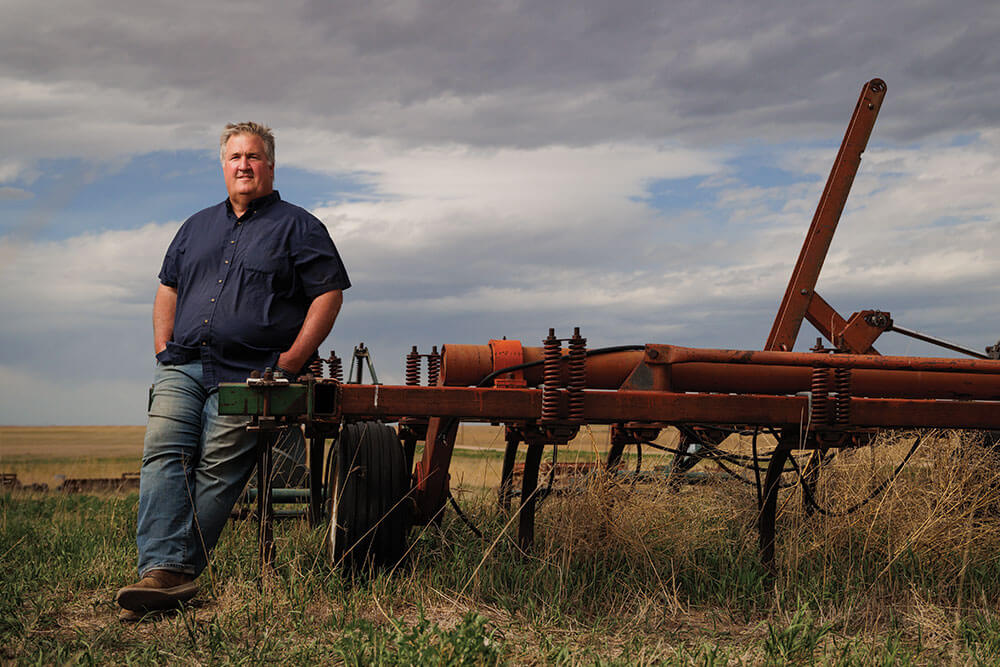
Equipment that once served to cut into the soil now serves as cover for wildlife — including pheasants and other grassland species that thrive at Tucker Farms.
Grazing builds healthy soil and increases biodiversity
The Grass Is Always Greener
When the Ebels purchased their northeastern Texas ranch, the ground was so poor and bare that desert-dwelling jackrabbits lived there. The land receives 45 inches of annual precipitation, so Karl Ebel knew he could do better.
Opting for goats instead of cattle due to the lack of forage, the Ebels bought 600 head and started a rotational grazing program. They replanted native species on roughly a third of the ranch, while leaving out areas where Karl believed the native seedbank, though severely weakened after decades of tillage and overgrazing, would come back.
It’s a call he’s glad he made.
Diversity builds on diversity. It’s a recycling loop that just keeps getting better.
Karl Ebel, Sulphur Bluff, Texas
Six years later, high-quality forages like Indiangrass and big bluestem had returned in those areas. As the grasses reappeared, the Ebels reduced goat numbers and added cows.
While the Ebels selected their native plantings for the region, Karl says there’s no replacement for what was originally there. Centuries-old plant materials, spread by grazing livestock, can now be found across the ranch and growing in well-rested pastures.
While Karl also uses prescribed burns and other management practices, he describes grazing management as his cornerstone for building soil health and, ultimately, biodiversity. Botanists have identified countless native plant species on the ranch. Meanwhile, more deer and wildlife also have taken up residence.
Karl credits biodiversity for these results, too. It gives him flexibility in grazing and opens opportunities for better profits. “Diversity builds on diversity,” he says. “It’s a recycling loop that just keeps getting better.”
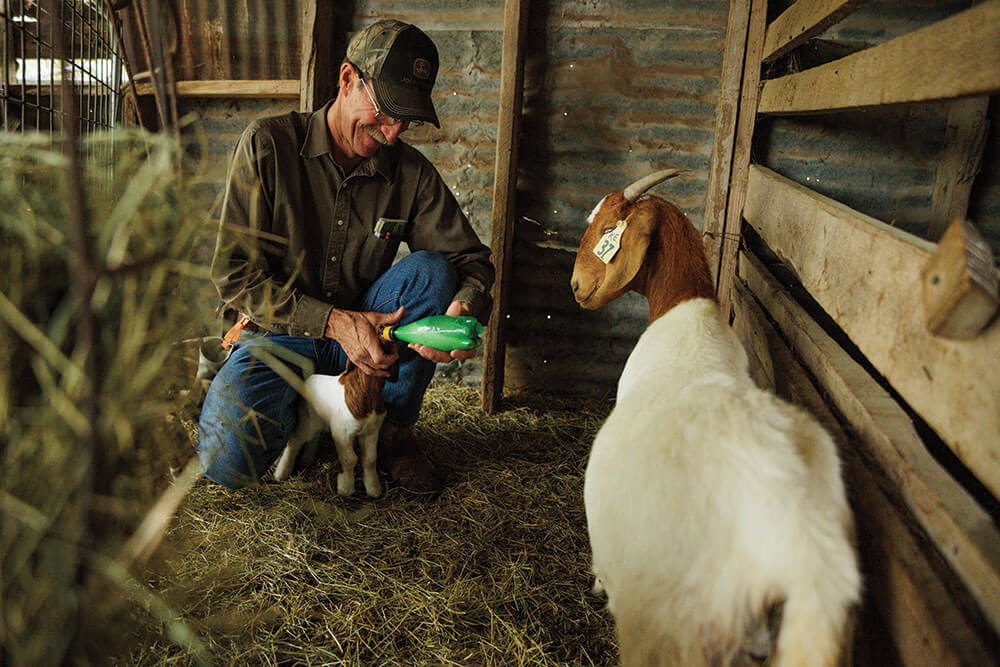
Karl Ebel bottle-feeds a late-arrival goat kid. Rotational grazing of goats and cattle plus other regenerative practices helped restore his Texas ranchland.
Come Rain or Shine
The Grass Is Always Greener
Kent Ferguson had not seen measurable rain on his ranch in Central Texas for more than six months. Then, it poured.
Heavy sheets pounded the land for 10 minutes, creating streams of chocolate oozing from the neighbor’s ground across the road. On Kent’s land, however, most of the rain soaked in. What didn’t, ran clear.
Kent has spent the past 25 years honing his grazing management. Good grazing, he says, matches animal numbers with forage production, which is based on soil health. Healthier soil holds more water, making the land more resilient when rains do or do not fall.
Most of Kent’s land is covered in native species, and he moves cattle about every three to five days. He leaves 10 inches of standing forage in each grazed paddock, which grows back to about 24 inches by the time cattle return to it in 35-42 days. Some of his pastures include introduced species like bermudagrass and kleingrass, which can handle heavier grazing during periods of drought to allow native pastures more rest. Diverse and more productive forages are stockpiled for winter months to eliminate the need for hay.
You can miss rains and stay in a constant plane of production because you’ve got the moisture stored in the soil.
Kent Ferguson, Valley Mills, Texas
Building up a litter layer on top of the soil is important for insulation, Kent says. He calls it cheap insurance.
“You can miss rains and stay in a constant plane of production because you’ve got the moisture stored in the soil,” Kent says. “You’ve kept the moisture where it needs to be, so the soil and plants don’t stress as quickly or as bad. If you keep from overgrazing, it bounces back fast.”
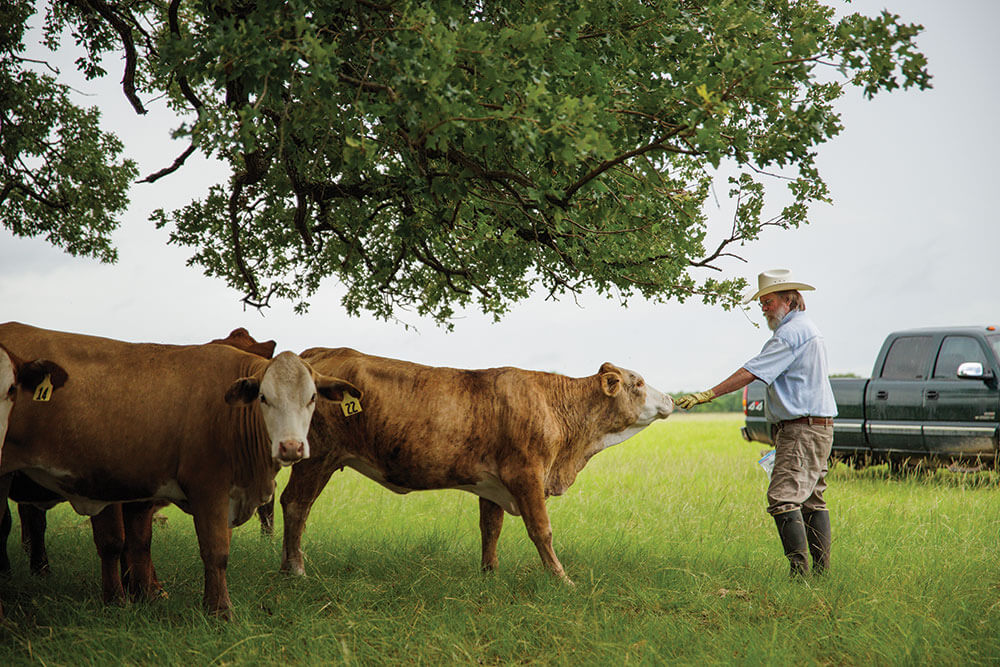
Moving cattle every three to five days builds connections with livestock and land. Kent Ferguson is greeted while collecting manure samples. The tests monitor how well he’s matching forages to his animals.
Improve water quality using nature’s filter
Cleaner, Clearer, Better
Beaver Creek runs alongside 1 1/2 miles of Mike and Jean Jones’ land in northwestern North Carolina. The Joneses purchased the first section of their property in 1974 and, for decades, their cattle drank from the creek and five smaller streams nearby.
In 1999, Beaver Creek flooded so much that beavers swam 100 feet away from what had been the banks. Since then, the Joneses have worked with various agencies, including the state Natural Resources Conservation Service, Forest Service and Wildlife Resources Commission, on improving their land.
Their first task was to fence the cows out of the surface water. They installed permanent drinkers that cattle can access instead, and, within a couple years, the creek healed itself. The edges of the meandering waterway became more prominent. The muddy banks, where cows once stood, were now filling in with walnut trees. Dragonflies, crayfish and other aquatic life also returned.
Keeping the soil covered with living forage is the best thing for water quality.
Mike Jones, Mount Airy, North Carolina
The Joneses had always used a form of rotational grazing, but they amped it up in 2009. They also planted native grass species into their tall fescue forage base.
“Keeping the soil covered with growing forage is the best thing for water quality,” Mike says. Roots make pathways for water to infiltrate the soil rather than run off into streams.
Runoff is minimal, and Mike is proud to say water has no chance to pick up excess synthetic nitrogen on its way to the creek and ultimately the Atlantic Ocean. The Joneses’ grazing management and added biodiversity helped them quit using fertilizer in 2016.
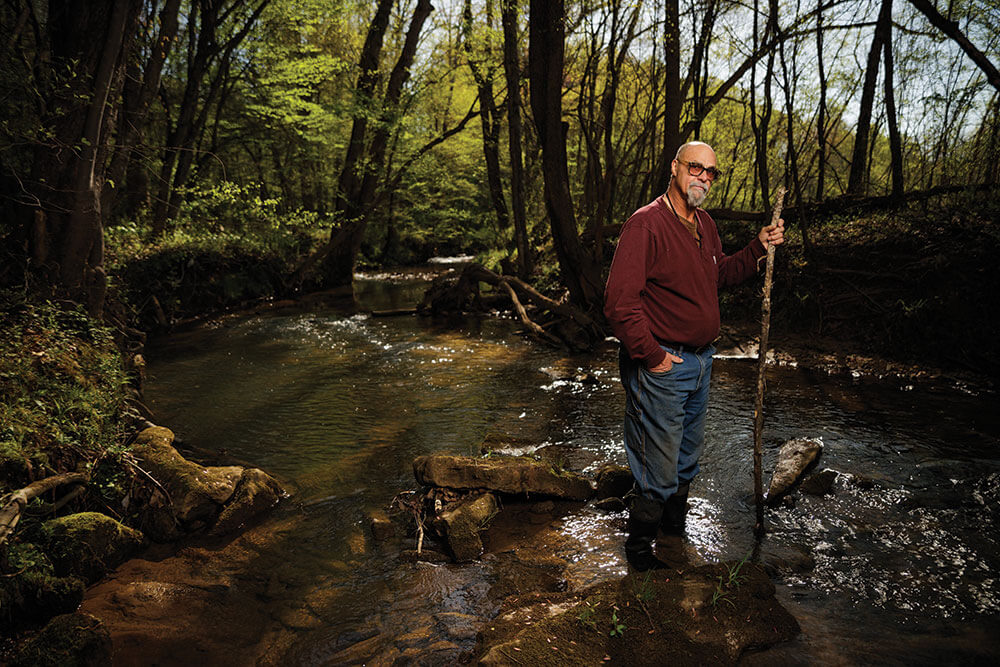
Mike Jones stands proudly in the clear waters of Beaver Creek. He and his wife, Jean, changed management practices and improved their land, giving new life and stability to the creek.
Regenerative ranching makes cents
Bank On It
Beth Hoffman worked as a journalist covering food and agriculture when she met her husband, John Hogeland, a chef-turned-butcher in San Francisco. John had grown up on a farm in southern Iowa, and soon the couple began making plans to move there and manage the family land.
Economics quickly became their greatest challenge, Beth recalls. She was surprised to learn how expensive it is to farm, a journey she wrote about in her book, Bet the Farm: The Dollars and Sense of Growing Food in America.
The couple started in 2019 by leasing land from John’s father and buying his cow herd. They decided on a low-input approach that would benefit both soil health and their bottom line.
They stopped all row cropping, which cut most machinery expenses, and converted cropland to pasture. They planted endophyte-free tall fescue, clovers and warm-season grasses.
Doing things in this alternative market means you don’t have to buy into the whole ‘bigger is better’ system and allows you to make a profit on a much smaller piece of land.
Beth Hoffman, Lovilia, Iowa
At first, John and Beth thought they would sell calves at the sale barn. However, once they realized how little they would make there, they decided to grass-finish and market beef themselves. They move cattle daily and have added goats.
Raising animals regeneratively opens opportunities to sell at higher prices compared to the commodity market, Beth says. Local consumers are interested in buying directly from the farm, and wholesale opportunities are on the rise. This is especially exciting to Beth, who sees alternative markets as the way to encourage farmers to adopt regenerative management.
“Doing things in this alternative market means you don’t need to buy into the whole ‘bigger is better’ system and allows you to make a profit on a much smaller piece of land.”
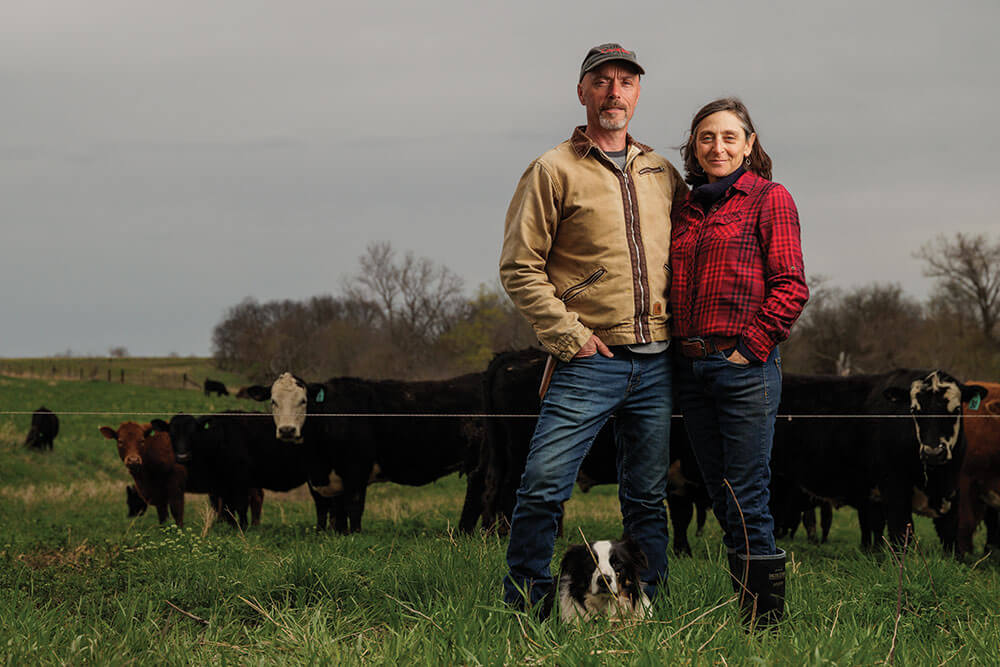
Beth Hoffman and John Hogeland, along with Snooks, enjoy their new life on their Iowa farm. Decreased inputs, regenerative grazing and selling their beef directly to consumers are building their future and their soil health.
Healthy soil decreases chemical inputs
When Less Is More
When Nick and Johanna Vos moved to the U.S. from South Africa and started farming in the southwestern Kansas/Oklahoma panhandle region, they adopted the same fertilization and herbicide programs as their neighbors. They applied synthetic nitrogen fertilizer and at least three rounds of herbicide to their corn and soybean crops.
Three years later, in 2010, they incorporated cover crops. That’s when they realized they didn’t need as much herbicide.
Weeds need a certain amount of nitrogen to grow. If cover crops deplete that nitrogen, the weeds won’t sprout. Nick says the diversity of the covers — a mix of brassicas, legumes and grasses — created a healthier, more balanced soil environment that suppresses weeds. Covering the ground between seasons is essential.
“People need to have something growing over the winter to feed the microbes and to break the pathogen cycle of a mono crop following a mono crop,” Nick says.
People need to have something growing over the winter to feed the microbes and to break the pathogen cycle of a mono crop following a mono crop.
Nick Vos, Hugoton, Kansas
Cover crops helped the Voses cut their herbicide use by two-thirds, and they are working to eliminate it and all other synthetic chemicals by integrating sheep into the operation.
Dorper hair sheep have been on the farm since its beginnings. However, adding cover crops gave the Voses a venue for raising sheep in higher numbers. The sheep add natural fertility to the soil and are gradually replacing herbicide as weed control. The sheep have also been more profitable than the crops, which is why Nick is moving toward a grazing-based operation where his diverse cropping will increase sheep production and soil health.
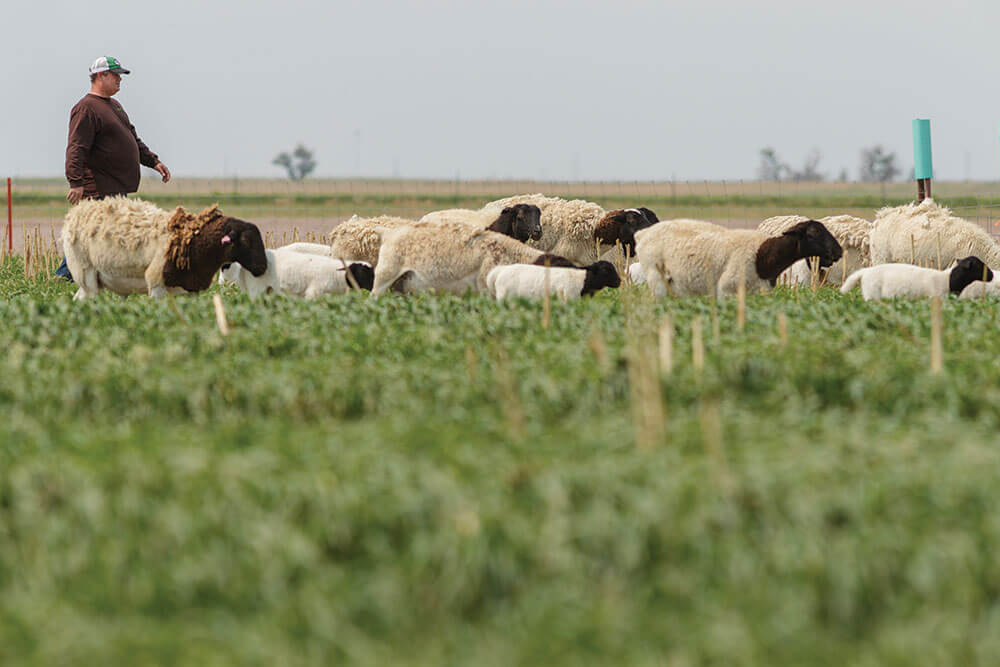
Nick Vos moves his Dorper hair sheep to a new pasture so he can irrigate this field during a severe drought. No-tilling, cover-crop rotations and grazing sheep help him cut inputs and overcome moisture challenges.
Building healthier soil also builds a wiser rancher
The Soil Savant
Phil Campbell’s father and grandfather taught him not to take everything from the soil. These were the lessons he and his three brothers learned while growing up on the family farm near Spencer, Oklahoma.
However, he never fully understood why until he started his own journey into regenerative agriculture.
Phil purchased his own farm near Luther, Oklahoma, in 2015, shortly before retiring from the Air Force. He and his wife, Debra, with their daughters, Megan and Morgan, planted a variety of fruit trees, started a herd of Angus cows, and added a flock of Rhode Island Red laying hens.
At the recommendation of one of his brothers, Phil reached out to the local Natural Resources Conservation Service early on to talk about his goals and resource concerns. His initial concern was water. That led to a discussion about eastern red cedars, which he learned take a great deal of water needed by forages. He started controlling the brush, and he installed a pond and solar-powered well to rotationally graze his cattle.
We’re all on this journey. It’s best to do the journey together and to learn from each other’s experiences. To me, that’s ultimately why we’re here: to make each other better.
Phil Campbell, Luther, Oklahoma
Little by little, Phil began unraveling the mystery of his farm. He tested and discovered. Noted and considered. He worked with the natural flow of his land. What he realized, after years of trial and error and growing returns, was that every good fruit crop and every healthy cow was the direct result of the soil. That’s where success starts.
The wisdom from his father and grandfather finally hit home. You never deplete the soil. You build it. And, in return, the soil builds your farm.
Now, Phil takes what he’s learned and, as the conservation commissioner for central Oklahoma, shares his success and failures through educational field days so other farmers and ranchers can experience his success.
“We’re all on this journey,” Phil says. “It’s best to do the journey together and to learn from each other’s experiences. To me, that’s ultimately why we’re here: to make each other better.”
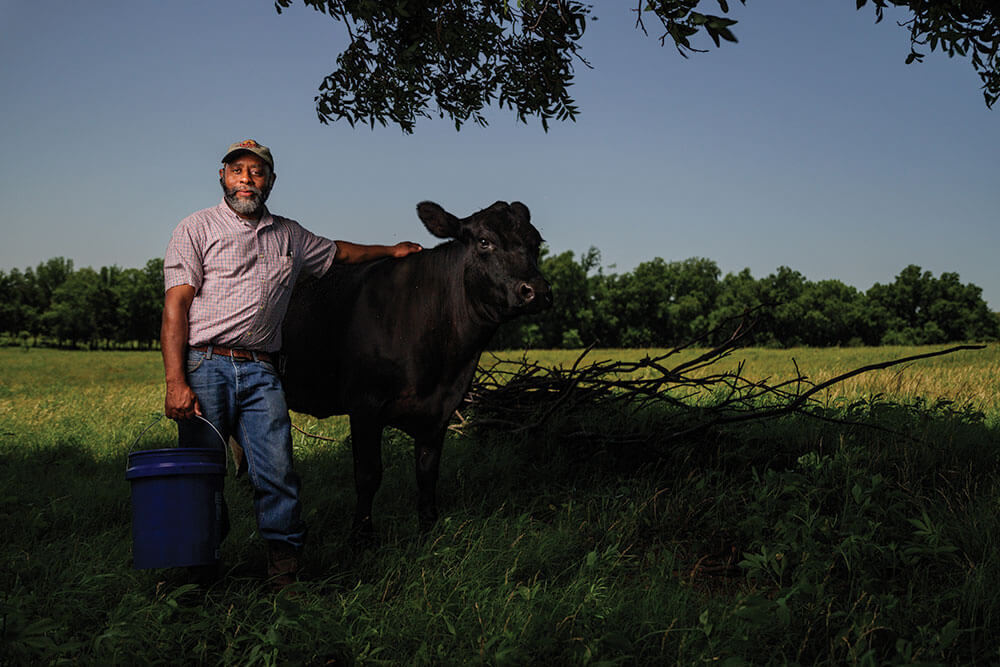
Phil Campbell (pictured with Cindy, one of his cows) walks his pastures to notice changes, does all he can by hand, and builds the soil to build his farm.
One Step At a Time
Introduction
Since implementing this new direction, Noble’s ranch managers have learned some hard lessons, while others have come more easily. They started by understanding the context of the ranches, how the land differs and functions from other land, and that perspective now serves as their decision-making guide.
From that point forward, the management changes have happened more naturally. Yes, it’s trial and error. But the errors become fewer; the successes happen more. The managers learned what to minimize or remove — soil disturbances like tillage, synthetic fertilizers and most pesticides — and what to add and integrate — livestock like cattle, sheep and goats. Rotational grazing brought life to the soil and forages, which resulted in more ground cover. Managing that grazing, along with planting cover crops, increased biodiversity and maintained continuous living roots in the soil.
Greatness can only come to any individual when they recognize that they have much to learn.
Lloyd Noble
Founder, Noble Research Institute
These firsthand, practical experiences are how Noble will be able to walk with ranchers on the regenerative journey. Noble’s ranch managers are facing the challenges, obstacles and uncertainties that every rancher will face. Ultimately, they’re learning one simple truth: this is a journey of direction, not perfection.
Here are the lessons they can share after one year of regenerative ranching.
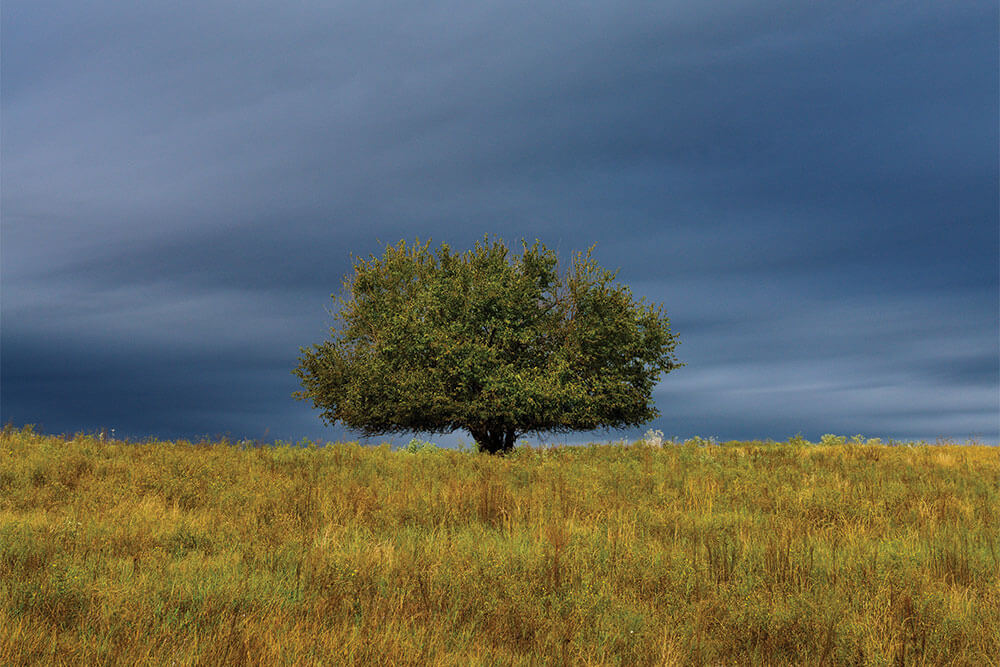
A solitary tree overlooks a regenerative pasture of polyculture forages on Noble’s Red River Ranch in Oklahoma. The sky shows the promise of early fall precipitation.
Principle 1: Understanding Your Context
Vive la Différence
A ranch in Oklahoma is different from one in Florida. They have different climates, terrains, markets, soil types. These differences are easily acknowledged, but what about differences between ranches in the same geographical region? What about the differences between one Oklahoma ranch and another?
That requires context.
“Context is a day-to-day process,” says Clark Roberts, ranch facility manager. “You’re constantly reevaluating your context because you have a context for the ranch, but you also have a context from pasture to pasture and season to season.”
Even areas of a single ranch can have different contexts due to different soil types, topography, management history and rainfall.
For Noble, understanding context began with recognizing that introduced pastures of the Pasture Demonstration Facility (PDF) and the Red River Ranch would need to be managed differently from native pastures at the Oswalt and Coffey ranches. For example, the shallower, rocky soils of Oswalt Ranch need longer grazing recovery times compared to the deeper soils of PDF.
Understanding context is crucial. Everything is constantly changing, and you have to adapt your management to your resources as things change. It can make or break you.
Clark Roberts, Ranch Facility Manager
Weather also plays a major role. Spring rains bring rapid forage growth, allowing cattle to move quickly through fields. At the end of the season, when forages decline in nutrient quality, pastures need more rest.
Clark and the rest of the ranch staff constantly observe how plants and grazing animals respond to their management. They look at manure and body condition scores for clues on animal health. They note how much of the plants have been grazed and how bright or dull they are as a result. They adjust as needed.
“Understanding context is crucial,” Clark says. “Everything is constantly changing, and you have to adapt your management to your resources as things change. It can make or break you.”
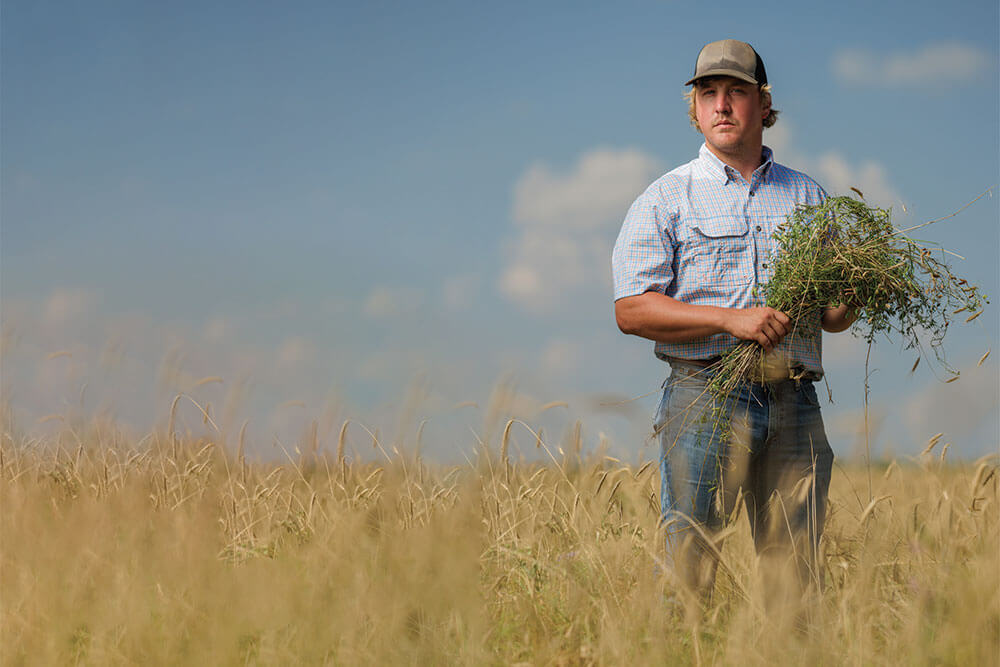
Clark Roberts moves cows, calves and bulls to the northern pasture of the Coffey Ranch for continued adaptive multi-paddock grazing on tall and lush mixed forages.
Principle 2: Cover the Soil
Don’t Get Burned
Covering the soil is like putting on sunscreen, says Curt Larson, ranch facility manager. Without protection from the sun, human skin is prone to blister. Bare soil, too, can boil, weakening its ability to support life both below and above ground.
Noble added cover to introduced pastures by planting diverse cover crop mixes and by closely monitoring grazing. Intensive grazing on small acreages, followed by rest, promotes forage growth and is adapted based on forage and animal performance.
Curt says it’s critical not to take too much cover so that pastures can recover, but it’s also important to be ready to graze when the forage is. A lack of grazing can eventually lead to brush, which cuts sunlight off from growing up new plants, especially the high-quality grasses. He found it can also make establishing cover crops difficult.
We’re building our soil deeper with all the biomass going back into the ground, in part from the cover. It’s also holding the moisture, which is pretty impressive.
Curt Larson, Ranch Facility Manager
Curt planted cover crops earlier this year so they had time to grow before the rain stopped and heat set in. It’s a process made easier due to the additional moisture the previous year’s covers helped the soil hold. Water does not evaporate as quickly from cooler, protected soils.
The results have been phenomenal.
Wheat is alive after six months of no rain. Even on the rocky Oswalt Ranch, moisture can be found 6-12 inches deep. In droughts past, ranch staff needed electric drills to collect soil samples. This year, a simple hand probe sufficed.
“We’re building our soil deeper with all the biomass going back into the ground, in part from the cover,” Curt says. “It’s also holding the moisture, which is pretty impressive.”
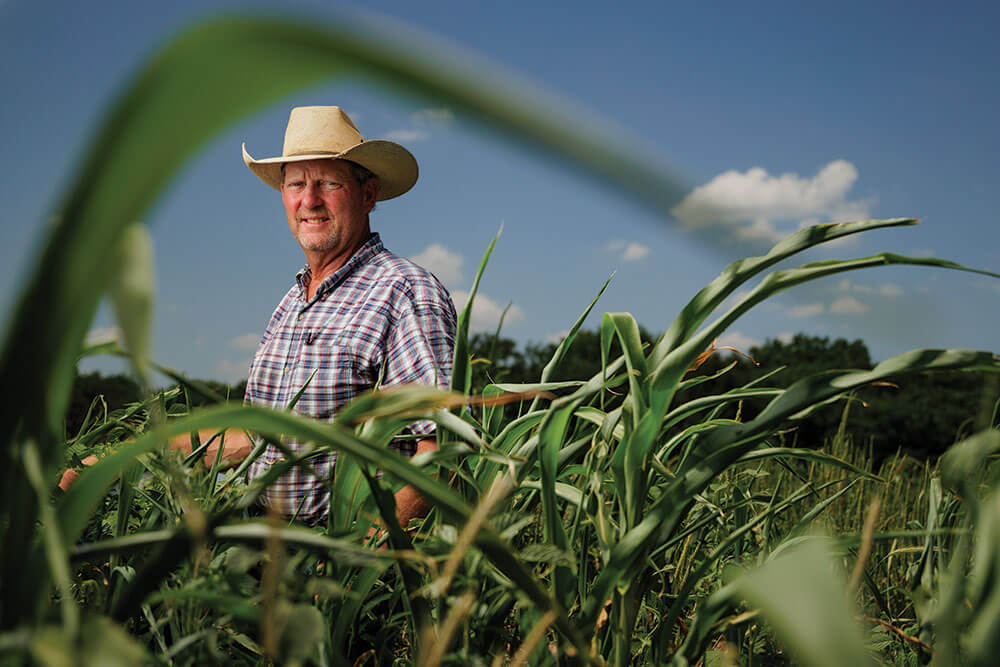
On Noble’s Oswalt Ranch, ranch facility manager Curt Larson stands among the mixed cover crops planted into introduced-species pastures. The diversity is helping build the soil deeper and hold on to precious moisture.
Principle 3: Minimize soil disturbance
Touch Me Not
Disturbance creates the opposite effect of covering the soil, says Paul Luna, ranch facility assistant. It weakens the soil and, eventually, can leave the ground bare.
Most people think of tillage, a form of physical disturbance, in conjunction with soil health. However, plowing is actually “slicing and dicing” the biological activity in the soil, Paul says. Other disturbances include biological, such as overgrazing, and chemical, like unnecessarily spraying pastures and applying fertilizer.
Previously, Noble ranch managers applied the industry-recommended amounts of fertilizer. However, routine use of fertilizer can encourage soil microbes not to create symbiotic relationships with each other and plant roots in order to eat. So, they stopped.
Once you’ve used cattle or any grazing animal to take down those weeds and get the soil right, the weeds become less
Paul Luna, Ranch Facility Assistant
of a problem.
Now, Noble no longer relies on synthetic fertilizers and pesticides. Noble ranch managers haven’t, however, cast these tools completely out of the toolbox. There are limited situations where fertilizer is needed to jumpstart growth to get the soil back to breaking down organic matter and building fertility.
Another example would be spot spraying an herbicide to get ahead of a bad case of cockleburs. They do not, however, use herbicides to terminate cover crops anymore or fertilizer to maximize forage production. They have also eliminated tillage and no longer bale hay.
More weeds have sprouted in certain areas, Paul says. However, he has already seen how targeted grazing can correct
the situation.
“Once you’ve used cattle or any grazing animal to take down those weeds and get the soil right, the weeds become less of
a problem.”
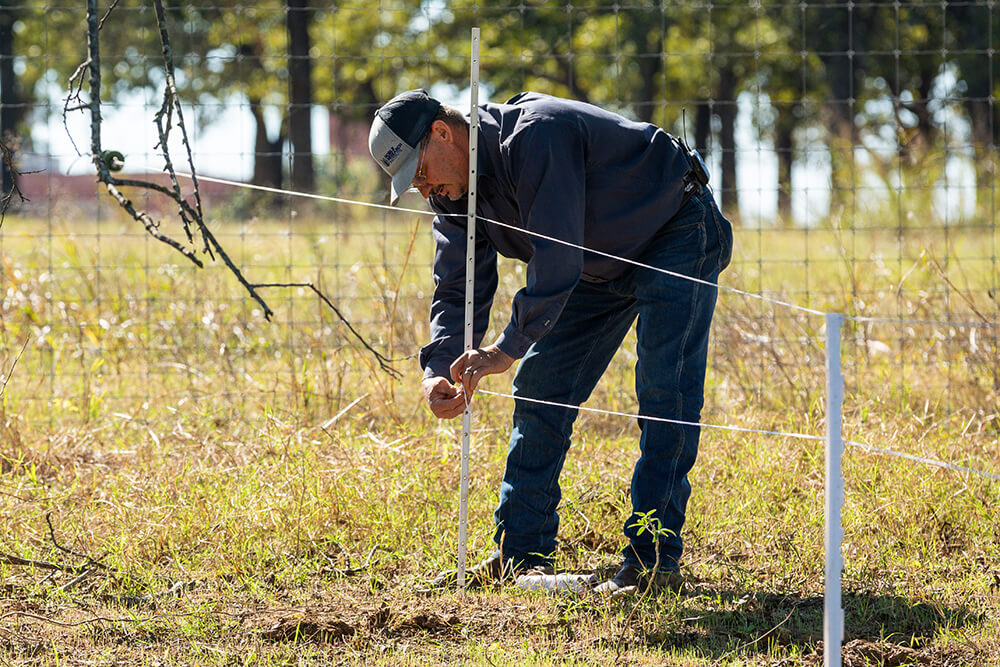
Paul Luna puts up a temporary electric polywire fence before moving cattle to the next grazing area on the Noble Headquarters Ranch. Targeted grazing is one of the tools used to combat weeds and improve soils.
Principle 4: Increase Diversity Above and Below Ground
Mix It Up
Brooks Braunagel saw increased biodiversity at Noble’s Pasture Demonstration Facility (PDF) within eight months of cutting out fertilizer and starting to graze more intensively.
Bermudagrass/crabgrass pastures interseeded with cool-season cover crops received at least 30 days of rest, and native grasses and forb species started coming back. Some of the natives had not been seen on PDF in more than four decades.
Soil health is now the priority on PDF instead of bermudagrass production, and bermudagrass has lost some of its dominance. It has not died, and that is not the aim, Brooks says. However, it has given more life a chance to thrive above and below ground.
Now, he sees more earthworms and dung beetles, a sign soil microbes are getting the raw materials they need from what grazing animals leave behind. He’s also seen benefits to the cattle.
Not only are we extending our grazing season exponentially with the cover crops, we’re increasing diversity in those areas. And the diversity is just unreal.
Brooks Braunagel, Ranch Facility Assistant
More forage options contribute to improved animal health. For example, lamb’s quarter, a forb popping up in bermudagrass, may provide medicinal qualities that promote good gut health. He has seen mineral intake already drop, not significantly, but enough to notice.
He has also seen cattle gain 2 pounds per day on summer cover crops without needing much grain or protein supplement. The cover crops, which follow winter small grains, have added the diversity of at least 10-15 different plant species. Each has its own advantages to give to the soil while providing forage for cattle and adding economic value to the ranch.
“Not only are we extending our grazing season exponentially with the cover crops, we’re increasing diversity in those areas,” Brooks says. “And the diversity is just unreal.”

Clutching samples of the wheat, hairy vetch and other legumes grown and grazed on Noble’s PDF in Ardmore, Brooks Braunagel marvels at the way such cover crops have benefited the livestock and the land.
Principle 5: Maintain Continuous Living Roots
Life Down Below
Living roots serve as ambassadors from the plant to the soil. They connect the two, providing nutrition to the soil in a way that keeps microbes active and healthy. They also anchor the soil, protecting it from winds that threaten to blow it away.
For these reasons, it’s important to keep living roots in the soil, says Kevin Pierce, ranch facility manager. Living roots help build up the soil and keep the ranch’s foundation strong.
Plant cover crops for soil health, to get those diverse living roots in the soil. If it works out to where there’s some to graze, that’s a bonus.
Kevin Pierce, Ranch Facility Manager
Kevin says keeping a living root in the ground primarily depends on not overgrazing, a priority on Noble ranches. While ranch staff have always rotationally grazed cattle, they now monitor grazing more closely and move cattle more frequently. Pastures of 60-100 acres were once grazed for five to 10 days. Now, those pastures have been broken into smaller paddocks using electric polywire, and cattle are moved daily. Cattle graze the forages down more evenly, and they are moved when about half is left. By the time they return to a particular area, the plants and their roots have had time to recover.
Cover crops also provide a living root in the soil, Kevin says. Roots’ ability to feed the soil makes them valuable as Noble seeks management-based strategies to improve fertility without synthetic fertilizer. Diverse mixes, including grasses, brassicas and legumes, add multiple benefits to the soil. Brassicas have deep roots that can aerate the soil and bust through plow pans, while legumes fix nitrogen.
Cover crops are good for grazing, but Kevin cautions against depending on them for forage. “Plant cover crops for soil health, to get those diverse living roots in the soil. If it works out to where there’s some to graze, that’s a bonus.”
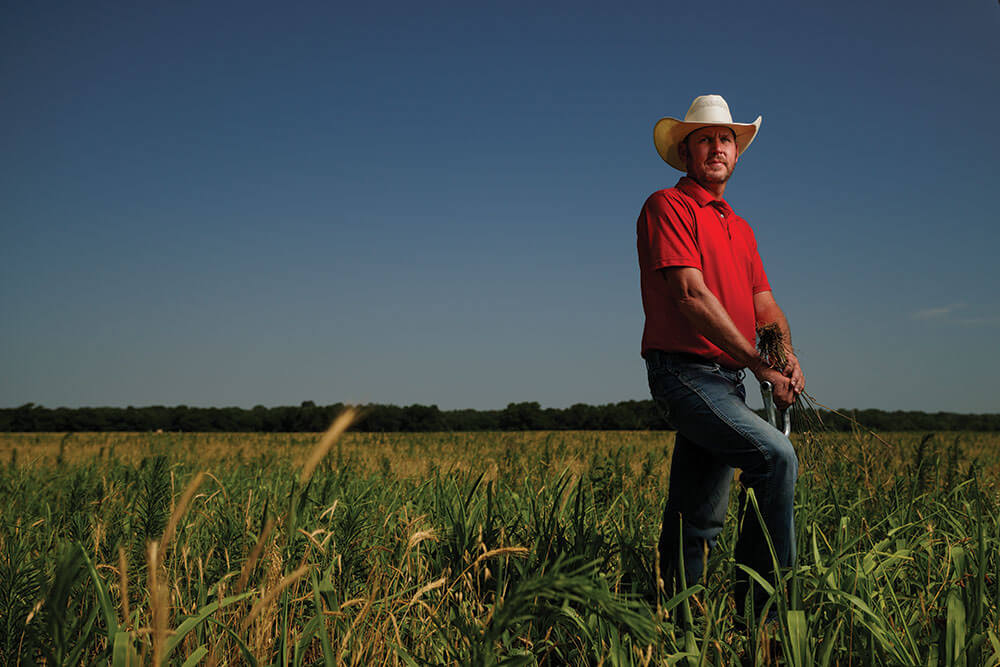
As ranch facility manager for the Red River Ranch, Kevin Pierce knows the importance of deep roots to protect the ranch’s sandy, river-bottom soil from being lost to the wind.
Principle 6: Integrate Livestock
What An Animal
The Noble ranches want to solve production problems with healthier soil. One of the best tools is grazing, says Joe Pokay, general ranch manager.
Livestock leave nitrogen-rich manure and trample mature forages, spreading nutrients across the pasture and stimulating plant growth. The key to maximizing the benefit of grazing is to consider both impact and rest. Plants and soils need time to recover, but Joe expects they will come back stronger as soil health improves.
Soil is the priority, Joe says, but its needs are balanced with animal performance. The land is grazed as intensively as each of the differing ranches can handle. The Headquarters Ranch, which is made up primarily of introduced species and diverse cover crops, can usually handle 200,000-300,000 pounds per acre more frequently than native grasses can.
We’re trying to integrate different species that eat different things. Having something that eats everything out there helps us manage pastures more holistically.
Joe Pokay, General Ranch Manager
Sheep joined cattle on Noble ranches in spring 2021 and goats a year later. Sheep graze more forbs than grasses, and goats like to browse on brush.
“We’re trying to integrate different species that eat different things,” Joe says. “Having something that eats everything out there helps us manage pastures more holistically.”
Grazing animals are going to parts of the ranch they have typically been fenced out of, too, like the pecan orchards. Joe intends to improve pecan production by using grazing to help build soil health. While livestock must be removed a few months prior to harvest to avoid cross-contamination, grazing under trees in the summer offers cattle much-needed shade.
Joe says it’s a system that only makes sense.
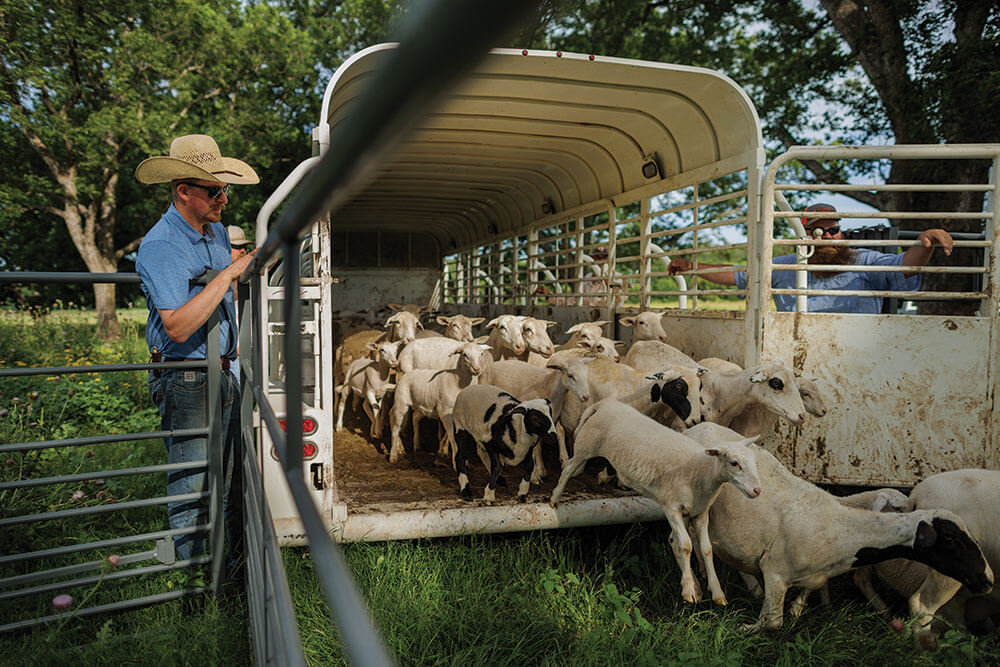
Dorper ewes and lambs arrive at the Red River Ranch under the watchful eye of Joe Pokay, Noble general ranch manager. Grazing both sheep and cattle uses more of the forage and adds profit to the operation.
Guiding Principle: Regenerative Is About Direction Over Perfection
Your MIND-field
This year has changed Chance Tynes’ mindset. The ranch facility manager grew up assuming you need a lot of herbicide and fertilizer to grow forage and add pounds to cattle. Now, he knows how powerful animal impact combined with rest can be in promoting forage growth.
Chance has seen how cover crops and biodiversity strengthen the soil and the whole operation. He is so convinced this is the right path that he is making changes in the way his family runs its own cattle operation. The prices of fuel, fertilizer and other inputs are too high not to, he says.
Chance has been amazed at the positive changes he has seen in the soil after one year of operating with a new mindset.
If you say you’ve got it perfect and quit, you’re in the wrong direction. I think if you continue on this path, you’re always going to see improvements.
Chance Tynes, Ranch Facility Manager
The Red River Ranch’s pecan orchards were sprayed for weeds several times each year in the past, leaving bare dirt beneath the trees. In 2021, the ranch staff planted cover crops and the grass grew twice as well as other years, even in a drought.
Other sandy spots that rarely sprouted high-quality grasses after years of regular herbicide applications started to fill in on their own once the spraying stopped.
The journey is not about getting everything perfect or doing it all at once. It’s about learning and moving forward, building on each small success.
“If you say you’ve got it perfect and quit, you’re in the wrong direction,” Chance says. “I think if you continue on this path, you’re always going to see improvements.”
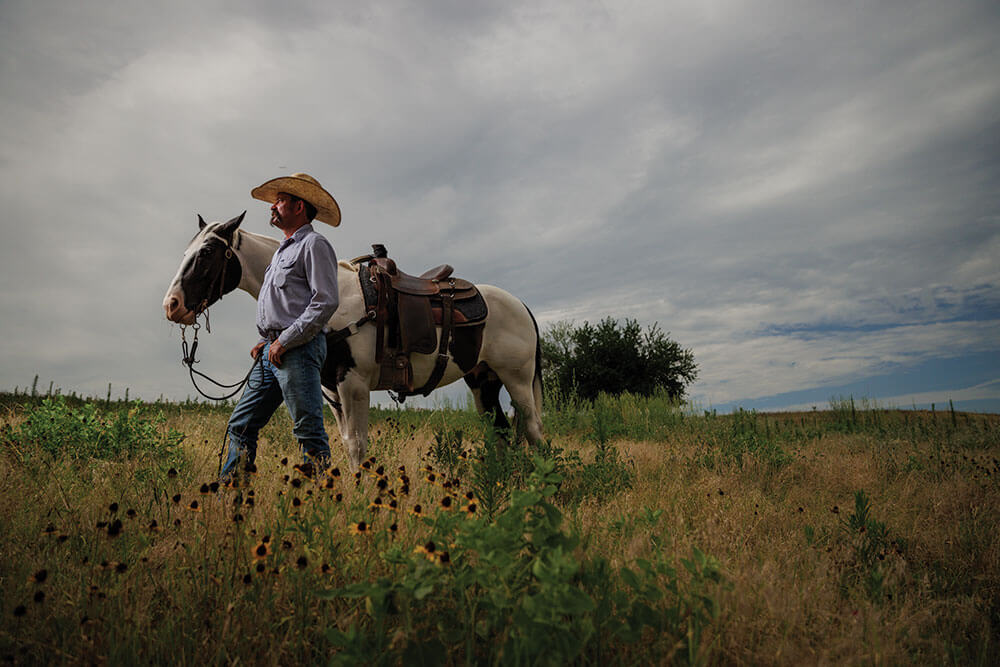
Chance Tynes and his horse, Geronimo, look across the expanse of the Red River Ranch. Witnessing great changes on the Noble Ranches has inspired him to start the regenerative journey in his family’s cattle operation.
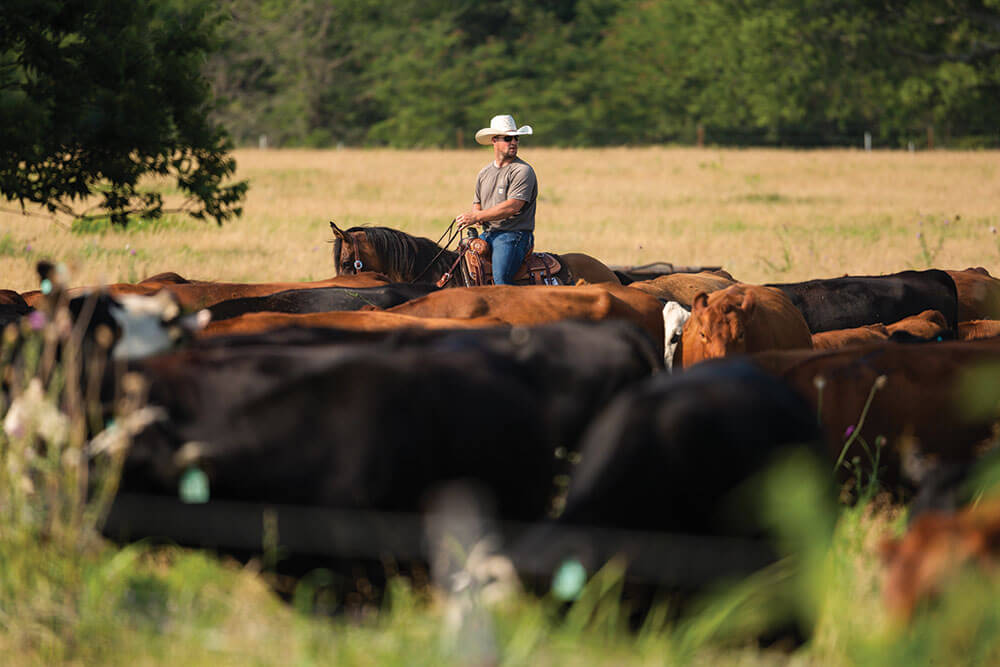
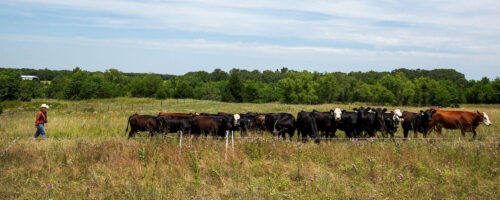
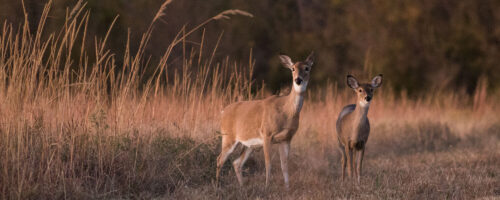
Comment